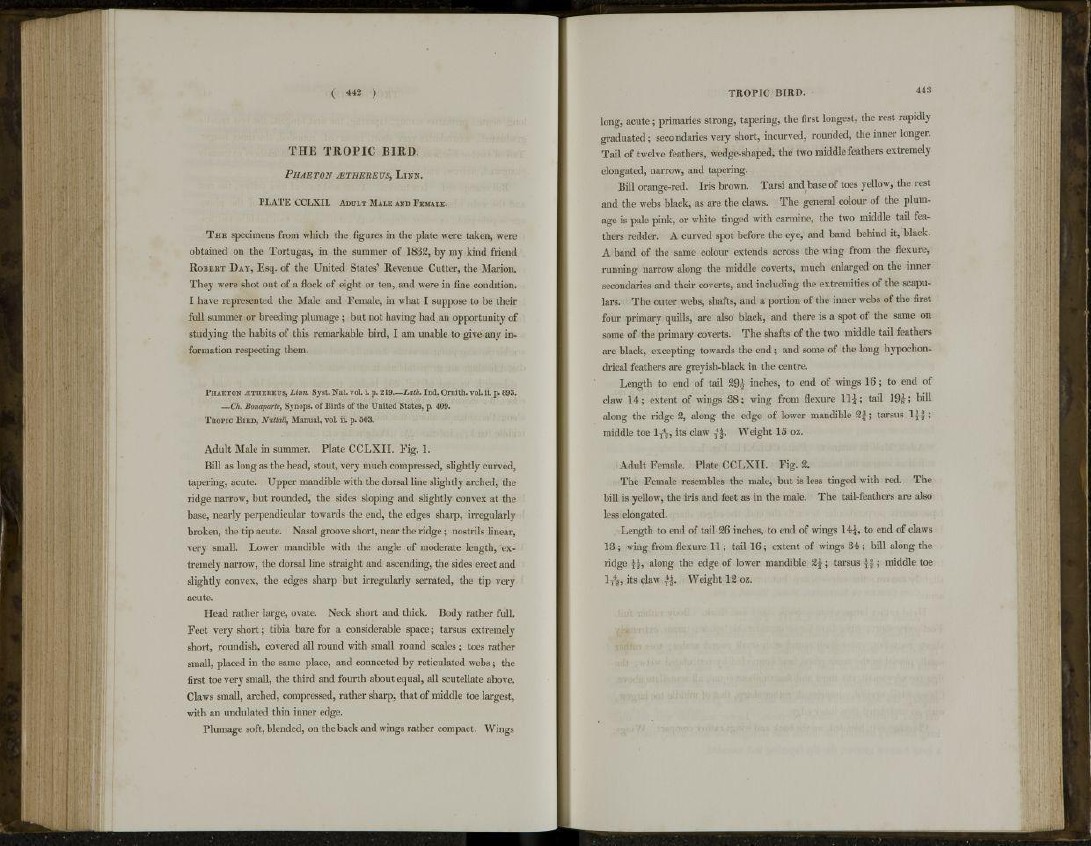
( 442 )
THE TROPIC BIRD.
PHAETON JETHEREUS, LINN.
PLATE CCLXIL ADULT MALE AND FEMALE.
T H E specimens from which the figures in the plate were taken, were
obtained on the Tortugas, in the summer of 1832, by my kind friend
ROBERT DAY, Esq. of the United States1 Revenue Cutter, the Marion.
They were shot out of a flock of eight or ten, and were in fine condition.
I have represented the Male and Female, in what I suppose to be their
full summer or breeding plumage ; but not having had an opportunity of
studying the habits of this remarkable bird, I am unable to give any information
respecting them.
PHAETON ^ETHEREUS, Linn. Syst. Nat. vol. i. p. 219—Lath. Ind. Ornith. vol. ii. p. 893.
—Ch. Bonaparte, Synops. of Birds of the United States, p. 409.
TROPIC BIRD, Nuttall, Manual, vol. ii. p. 503.
Adult Male in summer. Plate CCLXIL Fig. 1.
Bill as long as the head, stout, very much compressed, slightly curved,
tapering, acute. Upper mandible with the dorsal line slightly arched, the
ridge narrow, but rounded, the sides sloping and slightly convex at the
base, nearly perpendicular towards the end, the edges sharp, irregularly
broken, the tip acute. Nasal groove short, near the ridge; nostrils linear,
very small. Lower mandible with the angle of moderate length, extremely
narrow, the dorsal line straight and ascending, the sides erect and
slightly convex, the edges sharp but irregularly serrated, the tip very
acute.
Head rather large, ovate. Neck short and thick. Body rather full.
Feet very short; tibia bare for a considerable space; tarsus extremely
short, roundish, covered all round with small round scales ; toes rather
small, placed in the same place, and connected by reticulated webs; the
first toe very small, the third and fourth about equal, all scutellate above.
Claws small, arched, compressed, rather sharp, that of middle toe largest,
with an undulated thin inner edge.
Plumage soft, blended, on the back and wings rather compact. Wings
TROPIC BIRD. 443
long, acute ; primaries strong, tapering, the first longest, the rest rapidly
graduated; secondaries very short, incurved, rounded, the inner longer.
Tail of twelve feathers, wedge-shaped, the two middle feathers extremely
elongated, narrow, and tapering.
Bill orange-red. Iris brown. Tarsi and base of toes yellow, the rest
and the webs black, as are the claws. The general colour of the plumage
is pale pink, or white tinged with carmine, the two middle tail feathers
redder. A curved spot before the eye, and band behind it, black.
A band of the same colour extends across the wing from the flexure,
running narrow along the middle coverts, much enlarged on the inner
secondaries and their coverts, and including the extremities of the scapulars.
The outer webs, shafts, and a portion of the inner webs of the first
four primary quills, are also black, and there is a spot of the same on
some of the primary coverts. The shafts of the two middle tail feathers
are black, excepting towards the end; and some of the long hypochondrical
feathers are greyish-black in the centre.
Length to end of tail 29} inches, to end of wings 18 ; to end of
claw 14; extent of wings 38; wing from flexure 11£; tail 19£; bill
along the ridge 2, along the edge of lower mandible 2 | ; tarsus 1T§;
middle toe 1 T \ , its claw Weight 15 oz.
Adult Female. Plate CCLXIL Fig. 2.
The Female resembles the male, but is less tinged with red. The
bill is yellow, the iris and feet as in the male. The tail-feathers are also
less elongated.
Length to end of tail 26 inches, to end of wings 14£, to end of claws
13 ; wing from flexure 11; tail 16 ; extent of wings 34 ; bill along the
ridge T£, along the edge of lower mandible 2£; tarsus \% ; middle toe
1T
42, its claw | | . Weight 12 oz.